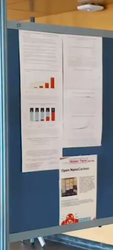Description
Model large-scale carbon dioxide removal and greenhouse gas phase-outs to verify temperature achieving close to 0ºC over the mean global temperature of 1850-1900 by 2100.
This paper runs a multi-step experiment on the climate model emulator (or reduced complexity model) MAGICC 6.8 to provide rationale for further exploration within an Earth System Model (ESM) to better project the climate under modest feedbacks while realizing final temperature evolution to match pre-industrial.
ONC doesn't have the funds or resources to run the experiments on a newer CDRMIP class Atmosphere-Ocean General Circulation Model (AOGCM).
About These Papers
These papers were conceived by Shannon A. Fiume in late 2017 during a conversation with Peter Fiekowsky as she was unable to find in the literature a way to return to the preindustrial climate within a hundred years of the present date while verifying how much carbon could be removed by scaled CDR in an exponential manner. By backtracking to the larger scoped question, if we were to target a lower temperature or preindustrial itself, this new goal could add an additional pathway to a more restored climate. Potentially this new goal could help limit damages by providing more literature for reducing emissions faster in the near term. Given the scientific gap, this project then shifted from a goal for ONC of what is the upper bound of carbon we ought to remove to the larger question of how much carbon would humans need to remove or have completed by 2100 in order to shift the climate back as close as possible to 0ºC over pre-industrial. See Shannon Fiume's comments on the CDR mailing list and Twitter for her conversations with the CDR community.
These papers are scoping exercises and technology-agnostic and as such, don't inherently fall into the category of presenting a Moral Hazard. To be more explicit, to achieve net-zero the fastest, mitigate a high-risk climate, limit further ecological loss and damages, and prepare to scale (fossil fuel-less) negative emissions for the next 70 years, it's necessary to have fossil fuels phased out as soon as possible and as such fossil fuels are therefore inappropriate to be used as a scaled source to generate net-zero or net-negative emissions. Humans have too many cumulative emissions to remove (think of running the carbon budget in reverse) to also add new emissions in any sizeable quantity.
Papers
Theory paper
Presented version: Targeting All Anthropogenic Carbon Dioxide Emissions (2018)
PrePrint (non-peer-reviewed) Revised version: Carbon Dioxide Removal Estimation Method to Remove Cumulative Anthropogenic CO₂ Emissions Distribution to Natural Sinks (2018, 2023), Alternative Method to Determine a Carbon Dioxide Removal (2018)
Author: Shannon A. Fiume
Description: A short paper outlining how much carbon we need to solidify for complete climate restoration and the carbon's location. It shows why 300 ppm and less need to be fully explored for complete climate restoration.
Currently in process of seeking additional funding for Open Access publication, needs to be resubmitted to a journal.
ExperimentalValidationPaper
Speculative scaled carbon removal modeling to return to preindustrial temperatures by 2100.
Experiments performed in collaboration with Foundation for Climate Restoration. Experiments to test how to achieve 300 ppm, then 280 ppm.
Author: Shannon A. Fiume
Shannon to present the findings of the paper and broader aspects of seeking climate restoration presented at a poster session at the AGU 2023.
Presented AGU-posterprint.pdf: Novel, speculative highly-scaled carbon removal study on a reduced complexity model, showing a return to preindustrial temperatures by 2100 and updates to achieving net-zero for Anthropocene reversal, B43K-2705, presented at AGU, 11-15 Dec. 2023, DOI: 10.22541/essoar.170365323.31209497/v1
Paper has still not been peer-reviewed currently in process of seeking additional funding for Open Access publication.
Related References
Global Carbon Budget 2017, 2018, Le Quéré, C., Andrew, R. M., Friedlingstein, P., Sitch, S., Pongratz, J., Manning, A. C., Korsbakken, J. I., Peters, G. P., Canadell, J. G., Jackson, R. B., Boden, T. A., Tans, P. P., Andrews, O. D., Arora, V. K., Bakker, D. C. E., Barbero, L., Becker, M., Betts, R. A., Bopp, L., Chevallier, F., Chini, L. P., Ciais, P., Cosca, C. E., Cross, J., Currie, K., Gasser, T., Harris, I., Hauck, J., Haverd, V., Houghton, R. A., Hunt, C. W., Hurtt, G., Ilyina, T., Jain, A. K., Kato, E., Kautz, M., Keeling, R. F., Klein Goldewijk, K., Körtzinger, A., Landschützer, P., Lefèvre, N., Lenton, A., Lienert, S., Lima, I., Lombardozzi, D., Metzl, N., Millero, F., Monteiro, P. M. S., Munro, D. R., Nabel, J. E. M. S., Nakaoka, S.-I., Nojiri, Y., Padin, X. A., Peregon, A., Pfeil, B., Pierrot, D., Poulter, B., Rehder, G., Reimer, J., Rödenbeck, C., Schwinger, J., Séférian, R., Skjelvan, I., Stocker, B. D., Tian, H., Tilbrook, B., Tubiello, F. N., van der Laan-Luijkx, I. T., van der Werf, G. R., van Heuven, S., Viovy, N., Vuichard, N., Walker, A. P., Watson, A. J., Wiltshire, A. J., Zaehle, S., and Zhu, D., Earth System Science Data, 10, pp. 405-448, DOI: 10.5194/essd-10-405-2018
Target atmospheric CO2: Where should humanity aim?, 2008, Hansen, J., M. Sato, P. Kharecha, D. Beerling, R. Berner, V. Masson-Delmotte, M. Pagani, M. Raymo, D.L. Royer, and J.C. Zachos, Open Atmos. Sci. J., 2, 217-231, DOI: 10.2174/1874282300802010217
